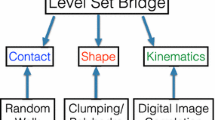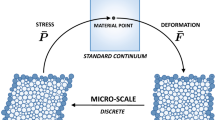Abstract
Through a first-generation computational mechanics avatar that directly links advanced X-ray computed tomographic experimental techniques to a discrete computational model, we present a case study where we made the first attempt to characterize and model the grain-scale response inside the shear band of a real specimen of Caicos ooids subjected to triaxial compression. The avatar has enabled, for the first time, the transition from faithful representation of grain morphologies in X-ray tomograms of granular media to a morphologically accurate discrete computational model. Grain-scale information is extracted and upscaled into a continuum finite element model through a hierarchical multiscale scheme, and the onset and evolution of a persistent shear band is modeled, showing excellent quantitative agreement with experiment in terms of both grain-scale and continuum responses in the post-bifurcation regime. More importantly, consistency in results across characterization, discrete analysis and continuum response from multiscale calculations are found, achieving the first and long sought-after quantitative breakthrough in grain-scale analysis of real granular materials.














Similar content being viewed by others
References
Alshibli KA, Hasan A (2008) Spatial variation of void ratio and shear band thickness in sand using X-ray computed tomography. Géotechnique 58(4):249–257
Andò E, Hall SA, Viggiani G, Desrues J, Besuelle P (2012) Grain-scale experimental investigation of localised deformation in sand: a discrete particle tracking approach. Acta Geotechn 7(1):1–13
Andrade JE, Avila CF (2012) Granular element method (GEM): linking inter-particle forces with macroscopic loading. Granul Matter 14:1–13
Andrade JE, Tu X (2009) Multiscale framework for behavior prediction in granular media. Mech Mater 41:652–669
Andrade JE, Avila CF, Lenoir N, Hall SA, Viggiani G (2011) Multiscale modeling and characterization of granular matter: from grain scale kinematics to continuum mechanics. J Mech Phys Solids 59:237–250
Andrade JE, Lim K-W, Avila CF, Vlahinić I (2012) Granular element method for computational particle mechanics. Comput Methods Appl Mech Eng 241–244:262–274
Andrade JE, Vlahinić I, Lim K-W, Jerves A (2012) Multiscale ‘tomography-to-simulation’ framework for granular matter: the road ahead. Géotechn Lett 2(3):135–139
Ashmawy AK, Sukumaran B, Hoang AV (2003) Evaluating the influence of particle shape on liquefaction behavior using discrete element method. In: Proceedings of the thirteenth international offshore and polar engineering conference (ISOPE 2003) Honolulu, Hawaii, May
Bowman ET, Soga K, Drummond W (2001) Particle shape characterisation using fourier descriptor analysis. Géotechnique 51(6):545–554
Cho GC, Dodds J, Santamarina JC (2006) Particle shape effects on packing density, stiffness, and strength: natural and crushed sands. J Geotechn Geoenviron Eng 132(5):591–602
Christoffersen J, Mehrabadi MM, Nemat-Nasser S (1981) A micromechanical description of granular material behavior. J Appl Mech 48:339–344
Cundall PA (1988) Formulation of a three-dimensional distinct element model—part I: a scheme to detect and represent contacts in a system composed of many polyhedral blocks. Int J Rock Mech Min Sci 25(3):107–116
Cundall PA, Strack ODL (1979) A discrete numerical model for granular assemblies. Géotechnique 29:47–65
Dascalu C, Cambou B (2008) Special issue on multiscale approaches to geomaterials. In: Dascalau C, Cambou B (eds) Acta Geotechn, vol 3. Springer, Berlin
Dubois F, Jean M (2006) The non smooth contact dynamic method: recent LMGC90 software developments and application. In: Wriggers P, Nackenhorst U (eds) Analysis and simulation of contact problems, volume 27 of lecture notes in applied and computational mechanics. Springer, Berlin, Heidelberg, pp 375–378
Garboczi EJ (2002) Three-dimensional mathematical analysis of particle shape using X-ray tomography and spherical harmonics: application to aggregates used in concrete. Cem Concr Res 32(10):1621–1638
Garcia X, Latham J-P, Xiang J, Harrison JP (2009) A clustered overlapping sphere algorithm to represent real particles in discrete element modelling. Géotechnique 59:779–784
Guo N, Zhao J (2014) A coupled FEM/DEM approach for hierarchical multiscale modelling of granular media. Int J Numer Methods Eng 99(11):789–818
Hall SA, Bornert M, Desrues J, Pannier Y, Lenoir N, Viggiani G, Bésuelle P (2010) Discrete and continuum analysis of localized deformation in sand using X-ray micro CT and volumetric digital image correlation. Géotechnique 60:315–322
Hall SA, Wright J, Pirling T, Andò E, Hughes DJ, Viggiani G (2011) Can intergranular force transmission be identified in sand? Granul Matter. doi:10.1007/s10035-011-0251-x
Hurley R, Marteau E, Ravichandran G, Andrade JE (2014) Extracting inter-particle forces in opaque granular materials: beyond photoelasticity. J Mech Phys Solids 63:154–166
Jones DR, Perttunen CD, Stuckman BE (1993) Lipschitzian optimization without the Lipschitz constant. J Optim Theory Appl 79(1):157–181
Koynov A, Akseli I, Cuitino AM (2011) Modeling and simulation of compact strength due to particle bonding using a hybrid discrete-continuum approach. Int J Pharm 418:273–285
Laursen TA (2002) Computational contact and impact mechanics: fundamentals of modeling interfacial phenomena in nonlinear finite element analysis. Springer, Berlin
Lenoir N, Bornert M, Desrues J, Viggiani G (2007) 3D digital image correlation applied to X-ray microtomography images from triaxial compression tests on argillaceous rock. Strain 43:193–205
Lim K-W, Andrade JE (2014) Granular element method for three-dimensional discrete element calculations. Int J Numer Anal Methods Geomech 38(2):167–188
Lim K-W, Krabbenhoft K, Andrade JE (2014) A contact dynamics approach to the granular element method. Comput Methods Appl Mech Eng 268:557–573
Lim K-W, Krabbenhoft K, Andrade JE (2014) On the contact treatment of non-convex particles in the granular element method. Comput Part Mech 1(3):257–275
Meier HA, Steinmann P, Kuhl E (2008) Towards multiscale computation of confined granular media—contact forces, stresses and tangent operators. Techn Mech 28:32–43
Mollon G, Zhao J (2014) 3D generation of realistic granular samples based on random fields theory and Fourier shape descriptors. Comput Methods Appl Mech Eng 279:46–65
Nguyen TK, Combe G, Caillerie D, Desrues J (2014) FEM \(\times \) DEM modelling of cohesive granular materials: numerical homogenisation and multi-scale simulations. Acta Geophys 62(5):1109–1126
Nocedal J, Wright SJ (2006) Numerical optimization, 2nd edn. Springer, New York
Oda M (1972) Initial fabrics and their relations to mechanical properties of granular materials. Soils Found 12:17–36
Phillips R (2001) Crystals, defects and microstructures: modeling across scales. Cambridge University Press, Cambridge
Rechenmacher AL, Finno RJ (2004) Digital image correlation to evaluate shear banding in dilative sands. Geotechn Test J ASCE 27:1–10
Regueiro RA, Yan B (2011) Concurrent multiscale computational modeling for dense dry granular materials interfacing deformable solid bodies. Springer series in geomechanics and geoengineering, pp 251–273
Saadatfar M, Turner ML, Arns CH, Averdunk H, Senden TJ, Sheppard AP, Sok RM, Pinczewski WV, Kelly J, Knackstedt MA (2005) Rock fabric and texture from digital core analysis. In: SPWLA 46th annual logging symposium, New Orleans, Louisiana, June, pp 26–29
Soille P (2004) Morphological image analysis, principles and applications, 2nd edn. Springer, Berlin
Tu X, Andrade JE (2008) Criteria for static equilibrium in particulate mechanics computations. Int J Numer Methods Eng 75:1581–1606
Vlahinić I, Andò E, Viggiani G, Andrade JE (2013) Towards a more accurate characterization of granular media: extracting quantitative descriptors from tomographic images. Granul Matter. doi:10.1007/s10035-013-0460-6
Weinan E (2011) Principles of multiscale modeling. Cambridge University Press, Cambridge
Wellmann C, Lillie C, Wriggers P (2007) Homogenization of granular material modeled by a three-dimensional discrete element method. Comput Geotechn 35:394–405
Acknowledgments
This work is partially supported by the NSF CAREER Grant No. 1060087 and the AFOSR YIP Grant No. FA9550-11-1-0052 of the California Institute of Technology. This support is gratefully acknowledged.
Author information
Authors and Affiliations
Corresponding author
Rights and permissions
About this article
Cite this article
Lim, KW., Kawamoto, R., Andò, E. et al. Multiscale characterization and modeling of granular materials through a computational mechanics avatar: a case study with experiment. Acta Geotech. 11, 243–253 (2016). https://doi.org/10.1007/s11440-015-0405-9
Received:
Accepted:
Published:
Issue Date:
DOI: https://doi.org/10.1007/s11440-015-0405-9




